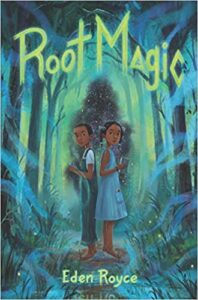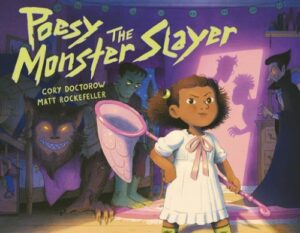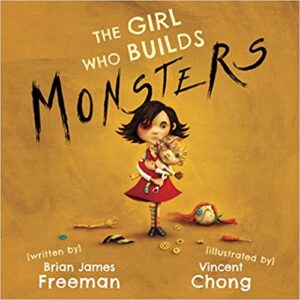
Root Magic by Eden Royce
Walden Pond Media, 2021
ISBN-13 : 978-0062899576
Available: Hardcover, Kindle edition, audiobook ( Bookshop.org | Amazon.com )
Root Magic takes place on Wadmalaw, one of the Sea Islands off the coast of South Carolina that is home to the Gullah-Geechee nation, a unique ethnic group with a combined heritage from African and indigenous individuals with its own language and traditions. Author Eden Royce, creates a vivid picture of Gullah-Geechee culture and traditions in the setting of the Sea Islands around the time of the Kennedy assassination though her eleven-year old narrator, Jezebel.
After her grandmother dies, Jezebel’s grandfather decides it is time to teach Jezzie and her twin brother Jay the basics of root magic for the purposes of protection, such as painting their house “haint blue” so evil spirits and boo-hags can’t enter, mixing potions, and creating root bags. The nearby marsh, previously a place the twins used to play, becomes dangerous as it tries to suck Jezzie in. Still, the twins are fascinated by root magic and can’t wait to learn more. Jezzie, in particular, starts to develop new powers, such as the ability to astrally project.
Things are not so easy at school. Jezzie has been jumped a year forward, and new girls from families with more money have moved to town. Jezzie, with her darker skin, mended clothes, and rumors of witchiness, becomes a target. Her only friend is Suzie, who can’t invite her over or visit her home, for reasons that become clear later. In his grade, Jay has become friendly with the other boys, and Jezzie is worried that her connection to him is breaking.
In addition to troubles at school, there are troubles at home. A police officer has taken a particular interest in Jezzie’s family, invading their home in their absence, demanding food, threatening them, and breaking their things. He knows they are a family of root workers and his behavior towards them escalates. While Jezzie and Jay do face supernatural threats in the book, it is Jezzie’s compassion to animals and creatures in trouble (including boo-hags) that helps protect her family from this dangerous but not at all supernatural threat.
Royce’s descriptions make it feel almost like the reader could step through to the island, and she is able to set the time period effectively with just a few sentences. Jim Crow and racist policing are alive and well, and that’s built into the story. Children questioning why the school would still be segregated, the police searching Jezzie’s house without a warrant, and the effect of the Kennedy assassination on the community will get their answers without an exposition dump. Royce’s presentation of the controversy over passing on root working practices both in the community and in the same family is also interesting, and she illustrates that root work is not a religion, but is a way of connecting with the world.
While the Gullah-Geechee nation became official in 2000, its existence is not well known, and it has a unique culture and language. Introducing Gullah-Geechee culture and language to a more mainstream audience through a middle-grade novel makes it very accessible. Eden Royce is a member of the Gullah-Geechee nation, and I think it would be very difficult to write about it from outside (in fact, there was a controversy over this not that long ago). Royce has a background as a horror writer for adults, with writing grounded in folklore and the Southern Gothic. I’m so glad she chose to use some of these same elements in this engaging historical Southern Gothic #OwnVoices novel for children. Children who enjoy this book may also enjoy Tracey Baptiste’s The Jumbies, Claribel A. Ortega’s Ghost Squad, and Marie Arnold’s The Year I Flew Away. Highly recommended for ages 8-12.
Contains: racism, police brutality, violence







Follow Us!